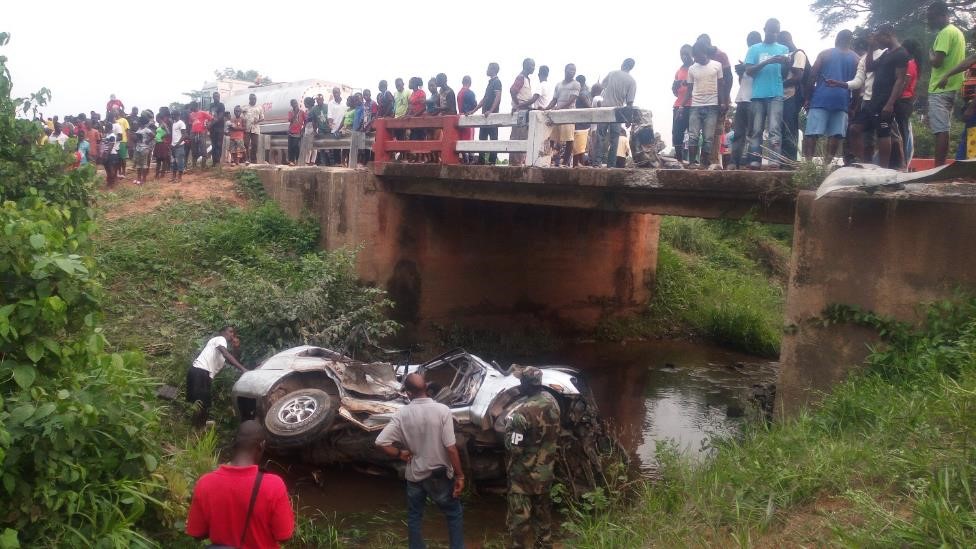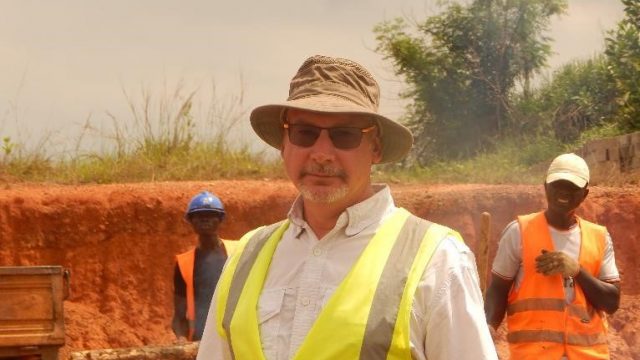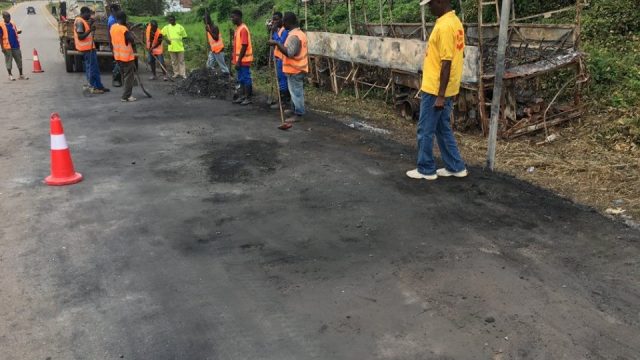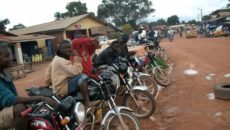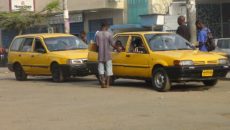GBARNGA, Bong – On April 18, 2017, a fatal road accident involving a silver Mitsubishi SUV and a motorcycle killed three people on a bridge entering Gbarnga.
The vehicle had veered off the rails of the bridge, breaking through and plunging into the stream below.
Accidents like this happen quite often on Liberia’s few miles of paved highways. According to the World Health Organization, Liberia has the second worst rate of road traffic deaths in sub-Saharan Africa.
While the human cost of accidents is familiar to most, there is another cost that Liberian taxpayers bear after every accident – the cost of cleaning up and restoring the roadway.
After an accident like this, contractors who are tasked with maintaining the highway remove debris, tow wrecked vehicles, and clean spills which result from traffic accidents. They also repair any damaged items, including signs, guardrails, and the road surface. In this case, the rails of the bridge would have needed to be repaired.
After the 247-kilometer road from Paynesville to the Ganta-Guinea border was constructed for US$249 million, the Chinese companies CICO and CHICO, which built different sections of the road, were tasked with maintaining the road in an excellent condition over a 10-year period through a performance-based contract.
This work is supervised by people like Richard Smith, who is the team leader for IMC Worldwide, the consultant responsible for monitoring CHICO’s performance on the stretch of the road from Gbarnga to the Ganta-Guinea border.
Smith said besides the average death of five persons per year on his stretch of the highway, the average cost of repairing damage caused by accident on the road is US$1,000. He said there have been at least 52 required repairs and replacement by CHICO since the stretch of the highway was completed.
“The statistics is showing two to three accidents per month in the first two years and the average cost of clearing up an accident is around a thousand dollars, but it varies from just a US$150 to as much as US$6,000 if we are replacing a long-length barrier that has been damaged,†he said.
“The contractor that we work with, CHICO, is reimbursed for all its work that it does on the road because of accident damages,†Smith added.
Given these statistics, Smith estimates that up to US$60,000 has been spent to deal with accident-related damages on the 70 km stretch. Extrapolating to the entire highway, Liberia has likely spent over US$200,000 on accident-related repairs since the highway was completed.
Right now, that money comes from a project fund, half of which is a loan that needs to be paid back by the Liberian government.
Although Liberia has a compulsory third-party motor-vehicle insurance policy to pay for third-party liability of vehicles during accidents, none of those policies are required to cover the cost of road infrastructure.
According to the assistant director for public affairs at the Ministry of Transport, Lemuel Kleeme, although having the insurance to cover damages to road infrastructure would help the government save money and serve as a disincentive for careless driving, the policy currently does not exist.
However, even Liberia’s antiquated Vehicle and Traffic Law of 1972 states that vehicle owners are liable and responsible for damage to properties. The law requires all vehicles to be insured for up to US$5,000 for injuries and destruction of property. In essence, the government could legally require vehicle owners found at fault for accidents to pay for the cost of cleanup and repairs, especially since the average cleanup cost is US$1,000.
Geoff Arnold, the deputy team leader of OPUS-ARUP, the consultancy monitoring CICO’s maintenance of the stretch of the road between Redlight and Gbarnga, said reducing the number of accidents not only reduces the cost for road maintenance; it also helps relieve the economy of the additional burden, including the cost for healthcare.
A road safety expert working with the Ministry of Transport’s Technical Support Unit wrote in an opinion piece that accident damages caused on the economy in 2017 alone are estimated at 7 percent of the GDP, or roughly US$140 million. Samuel Wonasue pointed out that, for every US$100 made by the Liberian economy, US$7 is lost just by not addressing the simple issues of road safety.
Wonasue believes, it is worrisome that most of the cost is shouldered by the Ministry of Health: “Can you imagine what another US$140 million a year would do for the health sector alone? More hospitals, doctors, nurses, and pharmaceutical drugs.â€
Featured photo by Moses Bailey
